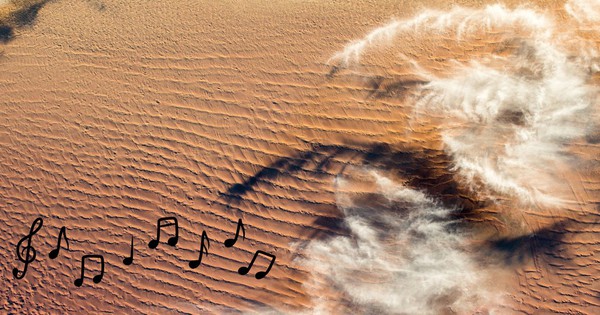Why Do Some Deserts Produce Mysterious Sounds?
Deserts are not always quiet landscapes. Under certain conditions, some sand dunes come alive with peculiar sounds – deep rumbles, booming noises, or even eerie whispers. This phenomenon, known as singing sand dunes, has fascinated explorers and scientists for centuries. But what causes these dunes to produce such unique sounds?
The Enigmatic Symphony of the Desert
In his 13th-century travels, Venetian explorer Marco Polo encountered singing sand dunes, which he attributed to evil desert spirits. He noted that they “sometimes fill the air with sounds of all kinds of musical instruments, as well as drumming and the sound of various instruments striking the arms.”
Reports of strange sounds have also been recorded in at least 35 deserts, ranging from California and Africa to China and Qatar, with deep buzzing sounds like bees or incomprehensible booming noises.

One thing is certain – these mysterious noises have baffled both desert explorers and scientists for years. For instance, Charles Darwin couldn’t explain the origin of the sounds he heard in the Chilean desert. However, today we are closer to unraveling this mystery.
The Science Behind the Song
The most widely accepted theory among the scientific community is that when dry, fine sand cascades downwind slopes of sand dunes, it collides and vibrates, creating sound waves. This theory aligns with observations that singing sand dunes often have crescent-shaped barchan dune formations, which have steeper slopes conducive to sliding sand.
In a 2005 experiment conducted in the Sahara Desert, Professor Bruno Andreotti from the University of Paris Diderot revealed that specific shapes and sizes of sand dunes can act as natural amplifiers, shaping vibrations into explosive or low-pitched sounds that we hear.

Andreotti measured the vibrations of sand and air to detect surface waves moving at speeds of about 130 feet per second (40 meters per second) generated by avalanches of sand on the dunes. These waves resulted from the collision of sand grains occurring roughly 100 times per second, creating synchronized rhythms.
The resulting sounds have frequencies ranging from 95 to 105 Hertz, similar to the sound of a drum or a low-flying propeller plane. This feedback process accurately predicts the phenomenon’s maximum volume at 105 decibels, equivalent to the noise level of a snowblower or maximum volume for personal audio devices, including loud radios, portable speakers, and televisions, or noisy entertainment venues like nightclubs and bars.
However, the mystery lies in the fact that not all sand dunes can “sing,” even under seemingly perfect conditions of wind speed, direction, and sand composition. There may be additional factors at play or specific combinations of necessary elements for this phenomenon to occur. Some researchers propose that a dry, denser layer beneath the loose surface layer may act as an amplifier or shape sound waves.

But how can a singing sand dune produce multiple musical notes simultaneously? To find out, a research team led by Simon Dagois-Bohy conducted a comparative study in two distinct locations: one in the southwestern Moroccan Sahara Desert and the other near Al-Askharah, a coastal town in southeastern Oman.
The Moroccan sand dunes consistently emitted a single note at a frequency of 105 Hertz, resembling a G two octaves below middle C, whereas the Oman dunes produced a broader frequency spectrum ranging from 90 to 150 Hertz, spanning about nine notes from F-sharp to D. Notably, the particle size in the Moroccan dunes was relatively uniform, while there was significant variation in Oman.
To delve deeper, the research team separated particles of different sizes and analyzed the sounds they produced when moving through the air in controlled laboratory conditions. They concluded that the sound emitted by the sand is influenced by both the particle size and their movement speed in the air.

Despite this profound understanding, how the irregular motion of sand grains generates harmonious musical notes remains unclear. Researchers speculate that the collective vibration of aligned sand grains resonates at a common frequency, causing the mass of particles to vibrate uniformly. This collective vibration creates thousands of small, converging movements that compress the surrounding air, similar to the operation of a speaker diaphragm.
“But why do they synchronize?” Dagois-Bohy remarks. “That remains unexplored and unexplained.”
References: [Earthlymission](https://earthlymission.com/), [Smithsonianmag](https://www.smithsonianmag.com/)

